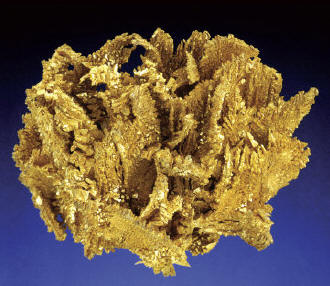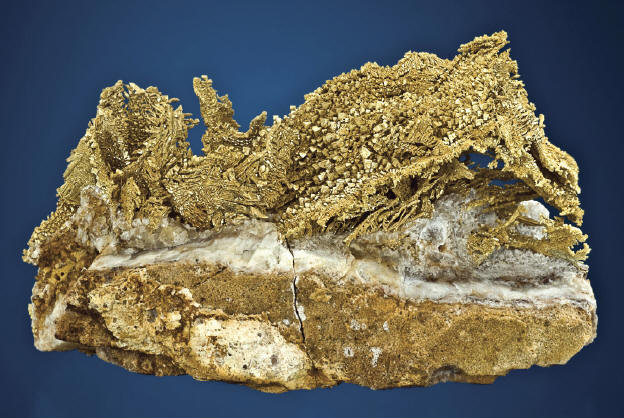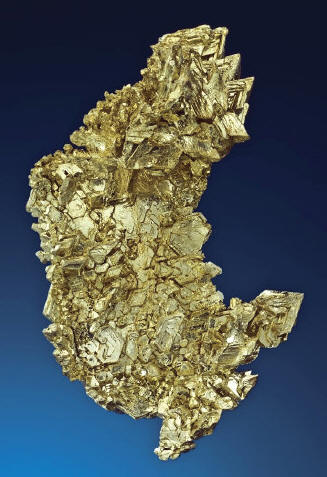
Twinned gold crystals forming casts after calcite. Size 5 cm. Ex Miner’s Lunchbox, now in private collection. J. Scovil photo.
Cubic crystals
Gold being in the isometric systemmight be expected to form as nice cubes.
Unfortunately, in nature, cubic crystalsare exceedingly rare. The presence ofabundant cubic crystals at Round Mountainis what makes the gold so uniqueand desirable. Most of the cubic crystalsare in the 1-2 mm range, but cubes tonearly 1 cm have been recovered! Often,cubes form in groups, sometimes aslarge as several centimeters across.
The cubes are mostly solid crystals, althoughhoppered-growth crystals similarto those seen in Venezuela are found.
Octahedral and more complex crystals
Octahedral and cuboctahedral crystalsare abundant, while more complexcrystal faces are less common in thegolds from Round Mountain. The mostcommon place to see the octahedrons isat the edges of leaves as discussedabove. The octahedrons are typicallyflattened, parallel to the leaf structure.
They can be less than 1 mm to greaterthan 20 mm. The best specimens haveperfect luster, although differences inluster of adjoining crystal faces are common.
Most of the octahedral crystalsshow hoppering or skeletal growth, afeature common to gold crystals all overthe world. The smaller crystals, especiallythose with higher order crystal faces tend to exhibit more solid crystalgrowth.While most crystals tend to format the margins of leaves, one pocket wasencountered consisting of large massesof intergrown octahedrons and spinellaw twins. Specimens to 15 cm were recoveredwith numerous 1-2 cm octahedronspresent in a mass of smalleroctahedral and elongate spinel lawtwins. These specimens were sold by themine in the year that had size limits onpieces bought by the miners. It appearsthat all of the pieces may actually havebeen from a single specimen greatly exceedingthe 150 gram limit imposed bymanagement. It has been hypothesizedthat the piece was broken up to accommodatethe size restrictions, and stillallow some truly great pieces to make itto the market.
Twinning
The feature that most significantlysets the Round Mountain golds apartfrom other localities is twinning. Spinellaw twinning (more accurately twinningon the 111 crystal plane) is extremelycommon in the deposit, and almost every specimen with well developed crystalshas at least a few twins. Like most golddeposits in the world, the most commonmorphology of twinned crystals is octahedral(a direct result of gold preferringto crystallize in octahedral form). Spinellaw twinning of two octahedral crystalsproduces a form resembling flattened octahedronsvisible at the leaf edges. Thetriangular steps that one can see on theflat surfaces of gold leaves (the featuregold collectors call “trigons”), are alsospinel law twins. The propensity of goldto twin in octahedral crystals is so strongthat we rarely observe simple completeoctahedrons (hence the elevated price ofgood octahedrons). Crystals exhibitingthe spinel law twinning of octahedral (orcuboctahedral) crystals at Round Mountainare typically less than 5 mm. Exceptionsto this occur where the crystals areelongated. Elongated twins to 3 cm areknown, and at least 3 specimens havebeen identified with elongated twins to 5cm. One gigantic gold crystal was foundwith a single hexagonal shaped spinellaw twin weighing 200 g! Unfortunately,it had some poorly formed crystals overgrowingthe twin so as to make it aestheticallychallenged.

Massive leaf grading into large spinel twinned cuboctahedral crystals. Size 6.5 cm. Mineral Exploration Services coll. J. Scovil photo.
Much less commonly, gold will formspinel law twins in cubic crystals. A favorite gold habit at the Round Mountainmine occurs where an entire leaf twinsso that the surface is covered with smallcubic crystals, all perched up in the sameorientation (the so-called homo-epitaxy).
This growth can be further modified by having the cubic crystals growing intwinned orientation out of the primaryoctahedral twins giving the appearanceof cubes perched on the hexagonalplates. The twins of cubic gold crystals also form on the herringbone leaves,which are a type of skeletal growth.

Herringbone leaves of gold. Size 7 cm. Private coll. J. Scovil photo.

Twinned gold crystals on herringbone leaves slightly folded by tectonic faulting. Size 8.5 cm. S. Werschky coll. J. Scovil photo.
Spectacular specimens form with parallelrows of flattened gold crystals connectedby a second set of parallelcrystals at 30° to the first set. On top ofthe two sets of parallel crystals there arerows of twinned cubic crystals allperched at an angle. The herringboneleaves often show folding or bending dueto tectonic deformations that occuredafter mineralization giving the effect ofundulating rows of cubes, which reflectincrementally as the specimen is rotatedunder light. A truly fantastic and beautifulthing!

Octahedral spinel law twinned crystals of gold showing silver-rich color typical for unoxidized rock. Size 4.1 cm. N. Prenn coll. J. Scovil photo.







 YueGongAnBei 44051102000467
YueGongAnBei 44051102000467


 |
|